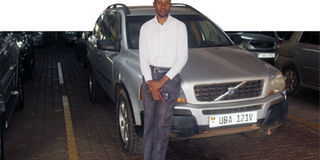Prime
The Volvo XC-90 is my perfect fit

What you need to know:
When Ivan Omoding decided to upgrade his car to one that could accommodate his growing family with ease, the Volvo XC-90 was an easy choice since it offered a number of safety features as well.
Ivan Omoding drives a 2003 Volvo XC-90. He previously owned a smaller Volvo but it could not accommodate his entire family. He also looked out for a car that guaranteed driving safety. As such, the Volvo XC-90 was the suitable replacement.
Safety features
One of the safety features that endeared Omoding to the Volvo XC-90 is the car’s structure, which he says is made up of boron steel that is approximately 20 times stronger than ordinary steel.
“It also has a number of airbags, including curtain airbags on the sides to protect one from side impact,” Omoding explains.
The Volvo XC-90 also has Side Impact Protection System (SIPS). When you are crashed from the sides, the car seats move towards the centre of the vehicle away from the crash impact even when you are wearing your seatbelt. It also has a feature, which if you lose control while driving at a high speed, the car automatically locks the steering wheel, moves in straight motion and eventually stops itself.
A Swedish brand that was one of the first models to be released in the SUV format, the maximum speed of Omoding’s car is 260km and runs on a 2500cc engine. It is a seven seater sport utility vehicle with two foldable seats in the trunk area. When you fold the seats, you have more space for luggage.
Service and maintenance
Omoding says nowadays, sourcing for and buying spare parts is quite easy. For instance, when he fails to get a spare part from Uganda, his alternative source is the United Kingdom. However, there are some parts that are readily available with different suppliers such as brake pads. He also subscribes to the Volvo Uganda Club where members have access to mechanics and spare parts dealers.
“A colleague recently took a photo of their damaged side mirror and one of the mechanics on the group came to their rescue. It is one of the advantages of being part of a car club,” Omoding says.
Some of the Volvo XC-90 parts that cannot be sourced locally are mostly electrical. For example, in case the computer system fails, you will have to source for it from the UK, Japan or Dubai. Common Volvo mechanical faults include the suspension shocks, suspension bushes and the engine mountings.
“Going to the garage depends on what requires to be serviced. It also depends on what the mechanic recommends to replace. Most of the Volvo parts such as engine components including the timing belt and tensioners have mileage attached to them. When you reach the prescribed mileage, you should have it replaced because it would have served its lifespan,” Omoding adds.
When he goes to the garage, Omoding replaces engine oil, oil filter, air filter and other crucial parts. The recommended synthetic engine oil (Castrol 5W30) for Volvo keeps him on the road for a further 10,000km from the current mileage. However, replacing engine oil also depends on how busy he is on the road. If he does not reach the 10,000km mark, the manufacturer recommends that his Volvo is serviced once a year or after every six months. According to Omoding, service costs range between Shs800,000 and Shs1m depending on what needs to be done. The engine alone uses six litres of synthetic oil, where a litre costs Shs55,000.
Reliable
Its performance on and off-road is not that of a 4WD car. It is an All-Wheel Drive (AWD) that is predominantly a front wheel drive. The front wheels give it power because there are not-so- many moving parts. It is a car you can easily rely on especially when driving on marrum roads. It has a smaller turbo driven engine but with enough power to take you through any road terrain.
Fuel
When doing urban or town drives, Omoding covers 20km per gallon, with a gallon having three litres. The car also has an on board computer that shows how much fuel you have used. Omoding’s car shows that he can cover approximately five kilometres per litre of fuel. There are also other Volvo models with engine variations of 2900cc and 3200cc, of which each has different consumption rates.




